Honor Award
50,000 Trees
Sarah Moos, Student ASLA, Graduate, University of California, Berkeley
Faculty Advisor: Judith Stilgenbauer, ASLA
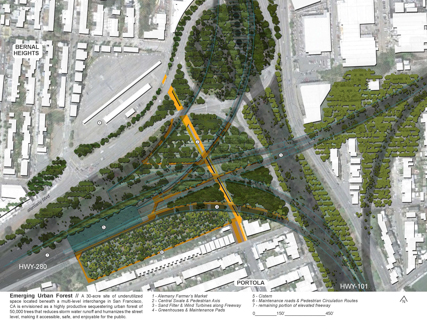 Close Me!
Close Me!Emerging Urban Forest
A 30-acre site of underutilized space located beneath a multi-level interchange in San Francisco, CA is envisioned as a highly productive sequestering urban forest of 50,000 trees that reduces storm water runoff and humanizes the street level, making it accessible, safe, and enjoyable for the public.
Download Hi-Res ImageImage: Sarah Moos
Image 1 of 15
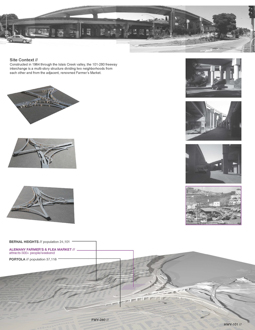 Close Me!
Close Me!Site Context
Constructed in 1964 through the Islais Creek valley, the 101-280 freeway interchange is a multi-story structure dividing two neighborhoods from each other and from the adjacent, renowned Farmer’s Market.
Download Hi-Res ImageImage: Sarah Moos
Image 2 of 15
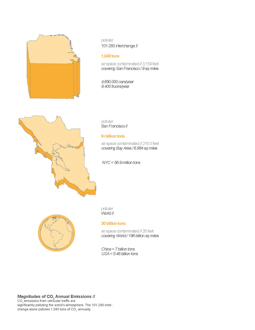 Close Me!
Close Me!Magnitudes of CO2 Annual Emissions
CO2 emissions from vehicular traffic are significantly polluting the world’s atmosphere. Urban forests have the capacity to remove CO2 and other pollutants from the atmosphere: 48,000 mature trees can sequester 1,040 tons of CO2 annually (Nowak).
Download Hi-Res ImageImage: Sarah Moos
Image 3 of 15
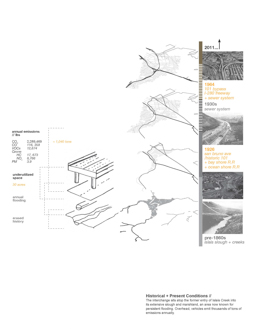 Close Me!
Close Me!Historical + Present Conditions
The interchange sits atop the former entry of Islais Creek into its extensive slough and marshland, an area now known for persistent flooding. Overhead, vehicles emit thousands of tons of emissions annually.
Download Hi-Res ImageImage: Sarah Moos
Image 4 of 15
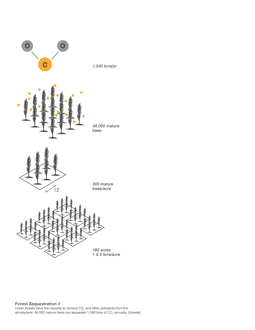 Close Me!
Close Me!Forest Sequestration
Urban forests have the capacity to remove CO2 and other pollutants from the atmosphere: 48,000 mature trees can sequester 1,040 tons of CO2 annually. (Nowak)
Download Hi-Res ImageImage: Sarah Moos
Image 5 of 15
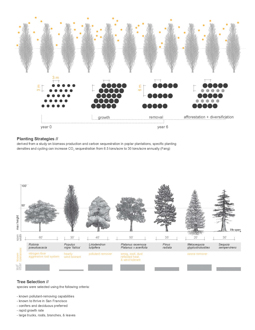 Close Me!
Close Me!Planting Strategies
Tree Selection Irrigation InfrastructureDerived from a study on biomass production and carbon sequestration in poplar plantations, specific planting densities and cycling can increase CO2 sequestration from 6.5 tons/acre to 30 tons/acre annually (Fang). Species were selected using the following criteria: 1) known pollutant-removing capabilities, 2) known to thrive in San Francisco, 3) conifers and deciduous preferred, 4) rapid growth rate, 5) large trucks, roots, branches, & leaves.
Download Hi-Res ImageImage: Sarah Moos
Image 6 of 15
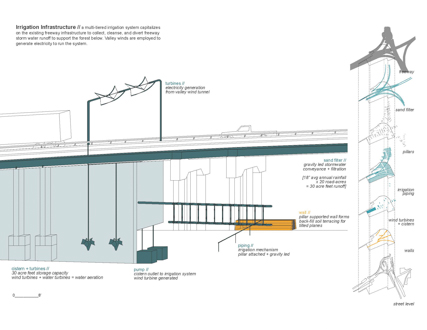 Close Me!
Close Me!Irrigation Infrastructure
A multi-tiered irrigation system capitalizes on the existing freeway infrastructure to collect, cleanse, and divert freeway storm water runoff to support the forest below. Valley winds are employed to generate electricity to run the system.
Download Hi-Res ImageImage: Sarah Moos
Image 7 of 15
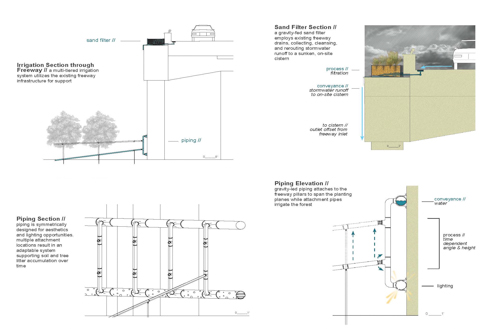 Close Me!
Close Me!Irrigation Section through Freeway; Bold Piping Section, Sand Filter Section and Piping Elevation
Irrigation Section through Freeway: a multi-tiered irrigation system utilizes the existing freeway infrastructure for support. Piping Section: piping is symmetrically designed for aesthetics and lighting opportunities. Multiple attachment locations result in an adaptable system supporting soil and tree litter accumulation over time. Sand Filter Section: a gravity-fed sand filter employs existing freeway drains, collecting, cleansing, and rerouting storm water runoff to a sunken, on-site cistern. Piping Elevation: gravity-led piping attaches to the freeway pillars to span the planting planes while attachment pipes irrigate the forest.
Download Hi-Res ImageImage: Sarah Moos
Image 8 of 15
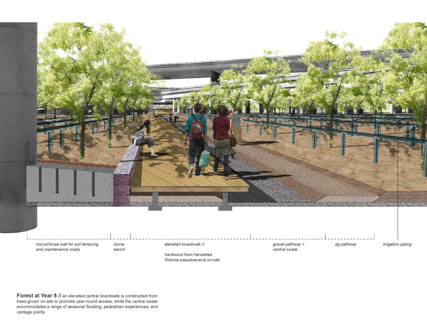 Close Me!
Close Me!Forest at Year 8
An elevated central boardwalk is constructed from trees grown on-site to promote year-round access, while the central swale accommodates a range of seasonal flooding, pedestrian experiences, and vantage points.
Download Hi-Res ImageImage: Sarah Moos
Image 9 of 15
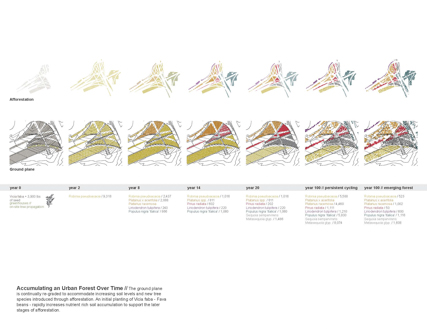 Close Me!
Close Me!Accumulating an Urban Forest Over Time
The ground plane is continually re-graded to accommodate increasing soil levels and new tree species introduced through afforestation. An initial planting of Vicia faba - Fava beans - rapidly increases nutrient rich soil accumulation to support the later stages of afforestation.
Download Hi-Res ImageImage: Sarah Moos
Image 10 of 15
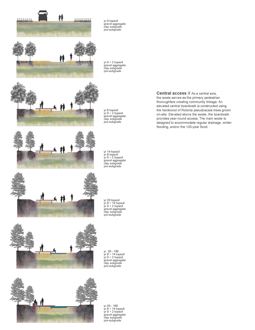 Close Me!
Close Me!Central Access
As a central axis, the swale serves as the primary pedestrian thoroughfare creating community linkage. An elevated central boardwalk is constructed using the hardwood of Robinia pseudoacaia trees grown on-site. Elevated above the swale, the boardwalk provides year-round access. The main swale is designed to accommodate regular drainage, winter flooding, and/or the 100-year flood.
Download Hi-Res ImageImage: Sarah Moos
Image 11 of 15
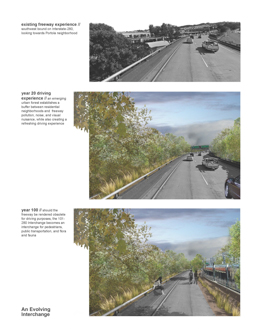 Close Me!
Close Me!Existing Freeway Experience; Year 20 Driving Experience; and Year 100
Existing: southwest bound on Interstate-280, looking towards Portola neighborhood. Year 20 driving experience: an emerging urban forest establishes a buffer between residential neighborhoods and freeway pollution, noise, and visual nuisance, while also creating a refreshing driving experience. Year 100: should the freeway be rendered obsolete for driving purposes, the 101-280 interchange becomes an interchange for pedestrians, public transportation, and flora and fauna.
Download Hi-Res ImageImage: Sarah Moos
Image 12 of 15
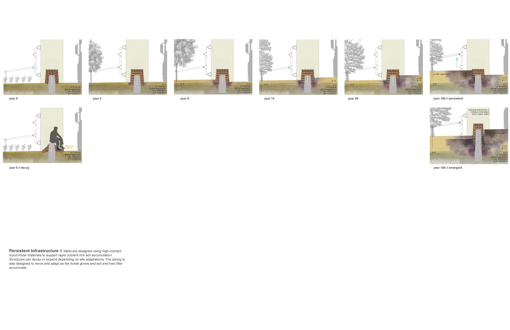 Close Me!
Close Me!Persistent Infrastructure
Walls are designed using high-nutrient micorrhizal materials to support rapid nutrient rich soil accumulation. Structures can decay or expand depending on site adaptations. The piping is also designed to move and adapt as the forest grows and soil and tree litter accumulate.
Download Hi-Res ImageImage: Sarah Moos
Image 13 of 15
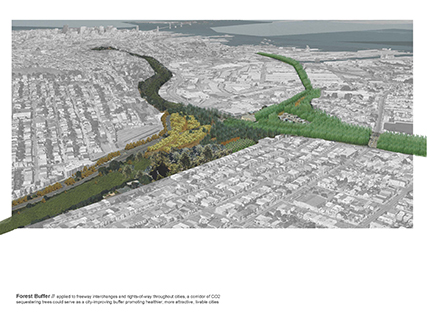 Close Me!
Close Me!Forest Buffer
Applied to freeway interchanges and rights-of-way throughout cities, a corridor of C02 sequestering trees could serve as a city-improving buffer promoting healthier, more attractive, livable cities.
Download Hi-Res ImageImage: Sarah Moos
Image 14 of 15
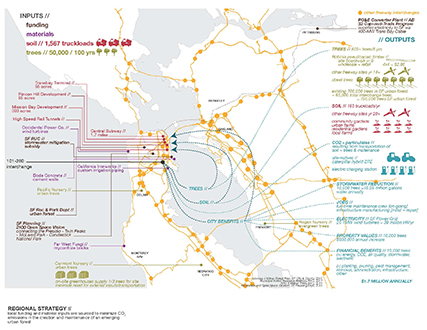 Close Me!
Close Me!Regional Strategy
Local funding and material inputs are sourced to minimize CO2 emissions in the creation and maintenance of an emerging urban forest.
Download Hi-Res ImageImage: Sarah Moos
Image 15 of 15
Project Statement
Designed to sequester CO2 emissions, an urban forest emerges on 30 acres of underutilized space beneath a freeway interchange in San Francisco, California. The design derives its form and planting regimen from scientific studies on carbon sequestration. The design capitalizes on existing infrastructure to devise irrigation, storm water reduction, and pedestrian access strategies that generate an estimated $1.7 million of annual city benefits and are applicable to interchanges throughout the San Francisco Bay Area.
Project Narrative
Purpose and Goals
30 billion tons of Carbon Dioxide (CO2) are emitted annually around the globe. The San Francisco Bay Area contributes 9 million tons annually. Currently anticipating 2 million additional residents by 2035, the San Francisco Bay Area will face inflated emissions. Asthma rates are projected to rise as a consequence.
Recent studies suggest that densely planted urban forests can sequester CO2 to offset annual emissions. Urban forests also improve air quality, provide enjoyable streetscapes, and establish buffers from dominating infrastructure. Freeway right-of-ways represent opportune land for locating sequestering forests in cities. They are some of the only remaining vacant land in San Francisco, they are often underutilized, and are adjacent to residential areas. Miles of elevated freeways contribute to a neglected, dangerous, and underutilized public realm at street level.
A 30-acre site of underutilized space located beneath a multi-level interchange in San Francisco, CA is envisioned as a highly productive sequestering urban forest that humanizes the street level making it accessible, safe, and enjoyable for the public. Design of the site had three primary goals. 1) Combine time, process, and ecology to offset CO2 emissions from the adjacent freeway while creating a memorable place. 2) Reduce persistent flooding on this former marshland. 3) Reconnect 2 neighborhoods to each other and to the city’s largest and renowned Farmer’s Market.
The design develops a systematic approach for planting a highly sequestering urban forest that capitalizes on existing infrastructure for irrigation needs and storm water improvements. Regional contributions identified for constructing this interchange forest guide a robust planning strategy that captures material and funding streams to plant urban forests in underutilized freeway right-of-ways throughout the entire San Francisco Bay Area.
Context
Constructed in 1964, the 101-280 freeway interchange is a multi-story structure spanning 1 mile in each direction. Located in a narrow valley, the interchange sits atop the former entry of Islais Creek into an extensive slough and marshland. The creek and marshland is now confined to an underground culvert and is responsible for annual flooding. The valley is also known for its extreme winds that billow from east to west across the interchange.
Two residential neighborhoods of Bernal Heights and Portola line the north and south sides of the interchange and are divided by the massive structure. Pedestrian interchange at street level is limited and confined to narrow, dark, and dirty sidewalks. Access to the adjacent and renowned Alemany Farmer’s Market is hindered by the presence of the interchange and there are limited plans to alter transportation routes or make pedestrian improvements.
These neighborhoods have been subjected to increased levels of freeway emissions and noise for years, decreasing real estate values and increasing asthma rates. Employing an urban forest as a freeway buffer could not only offset emissions but also contribute to improved property values and lifestyle.
Analysis
CO2 emissions were calculated for the expanse of the interchange using transit authority vehicle counts and average levels of annual emissions. , Within the expanse of the interchange, vehicles emit 1,040 tons of CO2 annually. Other emissions were calculated including Carbon Monoxide, Volatile Organic Compounds, Ozone, and Particulate Matter.
Research of contemporary forest sequestration techniques found that an average mature tree can sequester 48 lbs of CO2 annually (or 0.021 tons). , Sequestering 1,040 tons of CO2 using an urban forest would require 48,000 mature trees. If planted 12 feet apart, 300 mature trees can fit within a single acre and sequester 6.5 tons of CO2 per acre. This planting regimen would require 160 acres to sequester all 1,040 tons of CO2.
A study on biomass production and carbon sequestration potential in poplar plantations found that CO2 sequestration increases from 6.5 annual tons/acre to 30 annual tons/acre when specific planting and management strategies are used. These include planting trees 3 meters apart and cycling trees every 6 years, decreasing the acreage required to sequester 1,040 tons of CO2 annually. Analysis of these contemporary forest sequestration techniques informed a planting and maintenance strategy to sequester a portion of the 1,040 tons of CO2 and other compounds emitted annually at this interchange.
The study also suggests that CO2 sequestration increases for rapidly growing trees that possess large trunks, roots, branches, and leaves, those that are appropriate for the climate, and those that are coniferous or deciduous. Tree selection for the interchange includes eight rapidly growing trees known to thrive in San Francisco.
Methodology
Design form for the site follows these strategies by planting trees 3 meters apart and cycling the trees every 6 years through a process of growth, partial forest removal, and both afforestation and diversification. Using this planting regimen, the forest emerges over 100 years and accumulates 50,000 trees.
According to New York City’s 1-million tree program, an average urban tree requires 782 gallons of water per year. This design employs a multi-tiered regenerative catchment and irrigation system that latches to the existing freeway infrastructure. The system captures storm water runoff from the above freeway and irrigates the emerging forest below. A gravity-fed sand filter runs alongside the freeway, filtering storm water from existing drains while directing the water into an on-site cistern sunken beneath the freeway ramps.
Wind turbines above the freeway capitalize on excessive valley winds to power water turbines within the cistern for water aeration. Water is pumped from the cistern through piping that extends across the planted planes. The piping is designed to move and adapt as the forest grows and soil and tree litter accumulate.
By tilting the planting planes, drainage is oriented towards a main swale that is designed to accommodate regular drainage, winter flooding, and/or the 100-year flood. As a central axis, the swale also serves as the primary pedestrian thoroughfare creating community linkage. An elevated central boardwalk is constructed using the hardwood of Robinia pseudoacaia trees grown on-site. Elevated above the swale, the boardwalk provides year-round access. Two contiguous pathways of compacted decomposed granite and gravel provide alternative modes for movement along the central axis. Seat walls adjacent to the planted trees as well as occasional gathering platforms on the boardwalk offer viewing areas of the emerging forest. Maintenance roads and landing pads provide additional pathways for pedestrian circulation and enjoyment of the forest.
Implementation
To minimize CO2 emissions in the construction and maintenance of the emerging forest, funding and materials are locally sourced within the San Francisco Bay Area. Hybrid machinery is specified for tree maintenance and cycling.
Continuous forest cycling and irrigation strategies are projected to generate multiple city benefits: 500+ trees/year to grow the urban forest, 150 truckloads of nutritious soil/year for urban agriculture, 15.25 million gallons of storm water reduction, 39 million kW/year of generated electricity, property value increase of $900,000/year, and both local manufacturing and on-site maintenance jobs.
New York City’s 1-million tree program suggests that an emerging urban forest on the 101-280 freeway interchange would generate approximately $1.7 million of annual financial benefits for the city of San Francisco.
While specific tree species may change for location, an emerging urban forest could occur on at least 90 additional freeway interchanges throughout the San Francisco Bay Area. The result is a CO2 sequestering green buffer that spans and refreshes currently polluted metropolises. In a recent effort to employ urban trees as a tool of the Bay Area Climate Action Plan focused on reducing CO2 emissions, the City of San Francisco is utilizing the research, analysis, and design of this vision as part of the 2013 San Francisco Urban Forest Master Plan.




